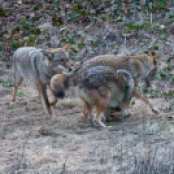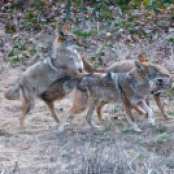My day and a coyote’s day overlap for only a few short hours on any given day: in the mornings shortly before the coyotes “turn in for the day”, and in the evenings, shortly before dark, when their activities pick up, but mine must come to an end because there’s no visibility in the dark. I was able to follow the goings-on of one coyote family from an early morning sighting, on through until it was too dark to see them anymore in the evening.
On this particular day I arrived as day was breaking and all was quiet. As I walked along, a female coyote came out to the path a ways in front of me. I stopped and watched, and I was watched back. She stretched and ambled on down the path, but soon stopped, sat down, scratched, and then gave me a good morning vocalization which reverberated loudly in the absolutely quiet and still of the morning. I listened for any responses from other coyotes, but there were none. The coyote poked around for a few minutes and then wandered in back of a bush where I lost sight of her until I went to the top of the next hill which allowed me to see her from above, sleeping in a little opening by some bushes.

hunkering down for the day

howling to communicate

surveying the area for activity
I sat watching, and then maybe 20 minutes later, I heard a very distant howl, and then right away a closer howl — two coyotes communicating with each other. The coyote which I was watching remained lying down, raising only her head to gave a short response — she was letting her family know where she was, and that she was safe. I remained on my hilltop where I could keep an eye on her: I wondered if/when she might move to a more hidden location.
As I watched, the coyote who had howled from the far distance — it was the young male whose signature howl I know well — trotted into view, and continued on, until he came to a little lookout knoll in the far but visible distance. He stood there for a while surveying the area. A couple of leashed dogs passed — I don’t think dogs or owners were aware of the coyote investigating the park activities.
Soon this coyote retraced his steps and, maybe because of their earlier communication, or maybe by scent, came upon the female sleeping by the bushes. She got up and the two greeted each other with mutual grooming. Eventually they both hunkered down together in that same little opening by the bushes.

male has spotted female

male and female greet and groom each other for several minutes

both coyotes hunker down for a long day’s rest
I left the park, but came back every several hours to find the coyotes had not moved. They were not so far off from the main path — maybe only 50 feet or so, but neither dogs nor walkers seemed to be aware of their presence. Maybe they were downwind from the path?

sleeping all day in the same spot: hidden but visible to me
Towards evening, I returned again to watch the coyotes begin their “day” anew. I perched at the top of the hill I had been on before. The coyotes were still asleep where I had last seen them. At around 6 — it was still sunny out — the male moved off to a location close by where he could watch the passers by and groom himself. Some people noticed him and took his photo from several hundred feet away. Within an hour, the female coyote, too, got up, stretched, and headed through the dense bushes. It is at this moment that sirens sounded. The male stood up, looked around, and began to howl. The female, from her hidden location in the bushes, joined in. The duo joyously sang their duet together in the warm afternoon sun. Their life appeared pretty harmonious to me.

Then, things changed. From my direction, and into view of the recording camera, came the alpha male. He was not happy with either the howling, or with the twosome howling together. He immediately lunged towards the male and forced him down on his back, growling threateningly to emphasize everything he was trying to communicate to the younger male. The female had her turn, but she more readily went belly up for the alpha male. After a few minutes of this intense dominance activity — these interactions never last long — they all settled down to wait.

calm after the storm, finally
Eventually the female got up and began wandering off. This is normally how the trekking begins in the evenings with this family: she’s the one who initiates the process and always heads off first. But when the younger male decided to join her, he was again accosted and put down hard by the alpha. I missed capturing the action or sounds because I wasn’t quick enough on the draw, but I can say that the loud squeals of pain were intense. When I looked over, dominant male was hovering over younger male again.

female heads off on her own

younger male is put down harshly by the alpha of the family
From that point on, younger male made no attempt to catch up with the departed female. He seemed to know that it was his job to stay with the alpha. They both remained in the field hunting together, and watching each other: the elder making sure the younger obeyed, the younger watching for feedback of approval or disapproval.

keeping an eye on each other

keeping an eye on each other
Half an hour later, these two males headed in the direction the female had gone. I followed them through the park and further, but soon I had trouble seeing, so my overlap time with the coyotes was over for the day. I’m always, always charmed by coyote interactions. This morning these coyote interactions had been so harmonious. This evening there had been dissonance and discord: when no question was left about who was boss, and exactly where each coyote fit into the family, life continued on smoothly. It occurred to me that the dominant male had things to teach the younger male, and that female needed time to herself which the older male knew about?
This family, like all coyote families, keeps in touch with each other constantly. They share a very close family life together, constantly doing things together. The dissonance which occurs is a check which keeps order in the family so that it can function smoothly as it hunts and lives. The time-frame for this story was about 15 hours.













































































































































